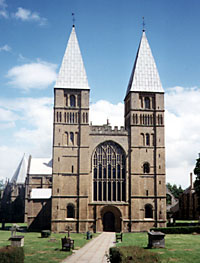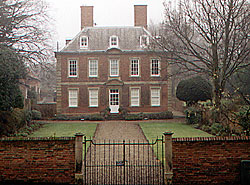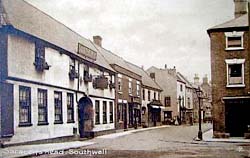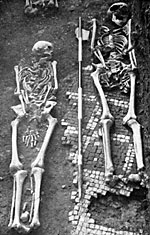
 |
The distinctive west front of Southwell Minster (photo: a Nicholson, 1985). |
Structual
Southwell Minster
The Minster has been described as a ‘village cathedral’ as it dominates the small town around it. Until the 19th century it was one of the great collegiate foundations in the diocese of York and from the 12th century acted as the mother church of Nottinghamshire. Collegiate churches, or minsters, were governed by a chapter of secular canons (priests in holy orders) who lived on the income from endowments of property and tithes known as prebends.
The layout of the church and its associated buildings has been determined by “the independence of the chapter and the individuality of its members”:
- The church is set in grassy lawns
- To south lies ruins of former palace of Archbishops of York
- To west and north stand the prebendal houses set in spacious grounds
- To the east lie Vicars’ Court and the Residence
Unlike other collegiate cathedrals these buildings were never surrounded by a walled enclosure or close.
Several distinct phases of building are discernible in the Minster fabric:
- The surviving fragments of the Saxon church: the carved tympanum and the remains of a tessellated pavement in the south transept
- The rebuilding of the Saxon church in the Romanesque style by Thomas II, Archbishop of York 1108-14 after raising the college at Southwell to the status of an important religious centre: the western parts of this phase survive today in the nave and transepts, including the crossing and western towers
- The rebuilding of the church east of the crossing and transepts in the 1230s
- The polygonal Chapter House with its exquisite decoration, dating from the late 13th century (c.1288)
An important collection of articles on the Minster’s architecture is:
- Jennifer S Alexander (ed.) Southwell and Nottinghamshire. Medieval Art, Architecture, and Industry, The British Archaeological Association Conference Transactions XXI, 1998 which contains:
- The Romanesque East End of Southwell Minster by Peter Coffman
- The Romanesque crossing capitals of Southwell Minster by Francis Kelly
- The chronology of the Choir of Southwell Minster by John McNeill
- Two-storeyed elevations: the Choir of Southwell of the West Country by Ute Engel
- Southwell Minster Choir: the evidence of the mason’s marks by Jennifer S Alexander
- The Leaves of Southwell revisited by Jean A Givens
- The Chapter House at Southwell Minster by Martin Stancliffe
The official guide is beautifully illustrated and provides a good introduction to the building:
- J Hall, M Short and S Pulford, Southwell Minster. The illustrated guide, Derby: English Life Publications, 1999
The official website is richly illustrated and very informative:
Buildings associated with the Minster
A comprehensive study of these buildings is provided in:
- N Summers, A Prospect of Southwell. An architectural history of the church and domestic buildings of the collegiate foundation, Revised Edition, Southwell: Kelham Publications, 1988
 |
Cranfield House was formerly Oxton I Prebendary (photo: A. Nicholson, 1985). |
The Prebendal Houses line Westgate and Church Street and took their names from the parishes from which their revenue was derived. A range of architectural styles are represented: South Muskham Prebend, until recently possessed a fine 15th century crown-post roof; Rampton Prebend dates from the early 17th century, though with an early 19th century facade; Oxton I Prebend, now known as Cranfield House, is a splendid Queen Anne building, erected c.1709; Normanton and Woodborough Predends are blessed with “handsome classical facades”; Sacrista Prebend has a stuccoed Tudor-Gothic exterior.
Vicars Court and The Residence are located to the east of the church. The Residence was built 1689-95, enlarged in 1772, altered in the 1780s (by Carr of York) and further changes made in 1806-9; the houses of the Vicars Choral were built in 1779-81.
The Bishops Palace to the south dates from 1907-9 and incorporates the ruins of the “remarkably large and monumental palace” of the Archbishops of York (see Ruins and earthworks section below).
Other buildings
The built heritage of Southwell is somewhat overshadowed by the Minster. However, there are a number of substantial houses built between 1790 and 1820 and a number of other buildings of interest.
 |
The Saracen's Head, c.1910. |
The Saracen’s Head is a former coaching inn with a close-studded timber-framed first floor dating from the 15th century. The adjoining Assembly Rooms were built in 1805 and now form part of the Saracen’s Head Hotel.
The House of Correction on Burgage Green was built in 1807 and extended twice in the 19th century. An impressive gateway fronts the site, although the complex behind it was severely damaged by fire in the 1970s and is now used for warehousing.
Burgage Manor was built around 1785-90 and is famous for its connection with Lord Byron having been his mother’s home from 1803 to 1808. Despite being at Harrow School and Trinity College in Cambridge during this period, Byron spent a considerable amount of time here.
The Thurgarton Hundred Incorporation workhouse at Upton opened in December 1824. The new building cost £6,596 to construct and was much larger than the original workhouse in the town, being designed to accommodate up to 158 inmates. The building has been restored by the National Trust. The guidebook is well illustrated and informative:
- Susanna Smith, The Workhouse Southwell: Nottinghamshire, London: National Trust, c.2002.
A good historical overview is available on The Workhouse website:
The entry on the National Trust website has some historical material:
Caudwell’s mill on the River Greet is a local landmark.
There has probably been a mill on the site for centuries but the current
mill was taken over by Charles Caudwell in 1851 and subsequently enlarged.
It closed in 1969 and has recently been converted into apartments.
English Heritage's Images of England website, which aims to create a 'point in time' photographic record of England's listed buildings, holds a large number of descriptions and photographs of listed buildings in Southwell:
Ruins & earthworks
The ruins of the palace of the Archbishops of York lie to the south of The Minster. The modern residence of the bishops of Southwell was created within its walls. The north, south and east outer walls of the courtyard-plan palace survive as the walled garden of the Bishop’s Manor.
- Harry Gill, Southwell Bishop’s Palace, Transactions of the Thoroton Society, 1905
- N Summers, A Prospect of Southwell. An architectural history of the church and domestic buildings of the collegiate foundation, Revised Edition, Southwell: Kelham Publications, 1988
Archaeological remains
 |
Skeletons lying on the mosaic floor of the Roman villa. |
A late Roman Courtyard villa lies to the south east of the Minster. Limited excavation carried out in 1959 established the villa’s east and south wings. The work uncovered an impressive cold bath (measuring 24 x 15.5 feet internally) and several mosaic pavements.
- Daniels, C M. Excavation on the site of the Roman villa at Southwell, 1959, Transactions of the Thoroton Society, LXX, 1966, 13-54.
Excavations following the demolition of the Minster School in 2008 have revealed the remains of a possible Roman temple complex:
Work on the site of the Minster Visitor’s Centre produced physical evidence (pottery) of Southwell’s Saxo-Norman archaeology:
- Lee Elliott, Excavations on the site of the Minster Chambers, Southwell, Nottinghamshire, Transactions of the Thoroton Society, 100,1996, 171–173
A useful re-assessment of Southwell and its environs is included in an article on the Roman military site at Osmanthorpe (2 miles north-west of the town):
- M C Bishop & P W M Freeman, Recent work at Osmanthorpe, Nottinghamshire, Britannia, 24, 1993, 159–189
Archaeological work in the town since 1998 is summarised in the Archaeology in Nottinghamshire section of the Transactions of the Thoroton Society and includes:
- John Samuels, South Minster School, Transactions of the Thoroton Society, 107, 2003, p207
- Lee Elliott, Southwell, Sacrista Prebend, Transactions of the Thoroton Society, 107, 2003, p207
- Pat Chapman, Southwell, King Street, Former Co-Op, Transactions of the Thoroton Society, 108, 2004, p197
Nottinghamshire County Council manages the Sites and Monuments Record (contains information on sites and finds of archaeological interest of all periods) and Historic Buildings Record (details on listed buildings).
There are 39 records for buildings, sites and monuments in Southwell on English Heritage’s Pastscape database
A search for ‘Southwell’ on the Essex University's Archaeology Data Service website gives 66 results.